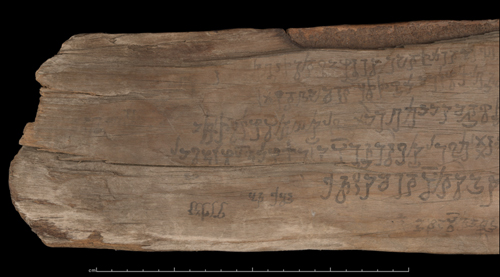Wood was often used for all manner of documents as it was cheaper and, in places, more readily available than paper. Most woodslips are messages written in ink on thin pieces of wood.
This particular wooden document is unusually large, containing writing in Gandari using Kharosthi script, it measures just under one meter in length. Age and use have faded the inks making the text difficult to decipher. As it is a very large document it requires photography in multiple sections, which can then be digitally stitched together to reconstruct the document.
Infrared photography has been carried out in the same sectional manner. The infrared image has improved readability and revealed text not previously visible under normal viewing conditions.
A final complete image has been produce from four separate infrared images. The stitched image allows the texts to be easily read, while the individual images provide the ability to study individual areas in greater detail.



